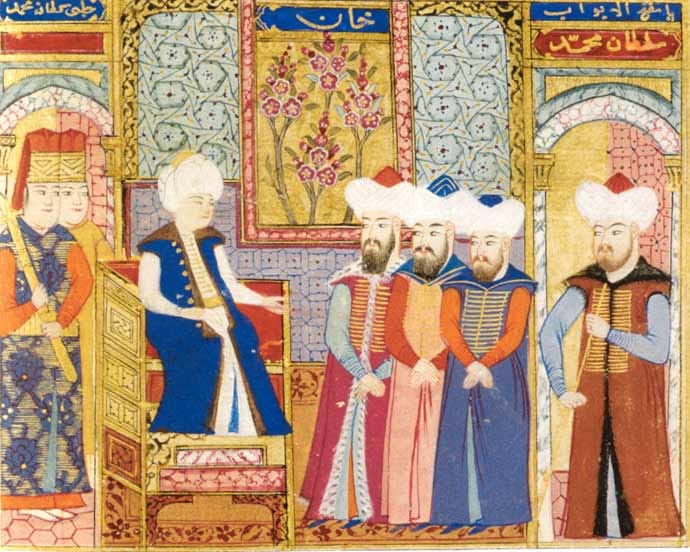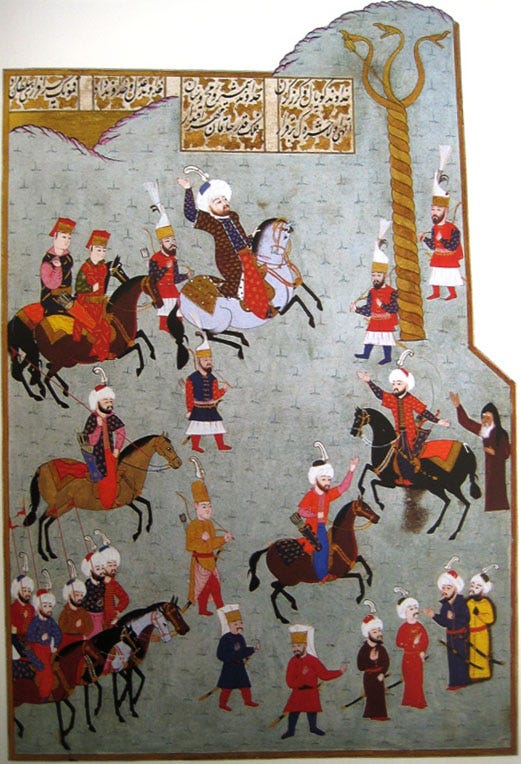Recently, I’ve been working on drafting my lectures for my upcoming online course on the history of the Ottoman Empire.
The process led me to revisit some of the texts on Ottoman history, something I hadn’t done for a long time. In that sense, it has been an informative experience for me as well, allowing me to look at the material with a fresh set of eyes.
In this post, I will share with you three observations from early Ottoman history that I hope you’ll find interesting. I’ve posted a version of these before in my Notes feed, but I’ve expanded them here, adding a bit more analysis.
Sufi Orders as Sites of Political Opposition
One dominant theme in early Ottoman history is the role Sufi dervishes played in the expansion of Ottoman territories. They were a crucial part of the Ottoman social fabric, and with the more heterodox form of Islam that they practiced, which was heavily infused with local beliefs and practices, they were influential in converting many Christians in the territories that the Ottomans conquered.
Over the years, however, as they became more of a state, the Ottomans started to adopt a much more hierarchical, centralized, and orthodox religious worldview, which meant that the practices of the Sufi orders were gradually marginalized.
The story of Sheikh Bedreddin was a case in point.
Bedreddin was a mystic Sufi. In his early life, he traveled widely and started to propagate his ideas in Anatolia in the early 1400s. These rested on two main pillars. 1) “communal ownership” and 2) “oneness of being” (meaning that God manifests itself in everything in the universe).
Bedreddin offered a fundamentally different vision of social and religious order, which threatened the very ideological foundation the Ottomans were trying to build. While Bedreddin’s vision rested on religious pluralism, communal property, and syncretic Islam, the Ottoman state advocated for Sunni orthodoxy, social hierarchy, and centralized authority based on an institutionalized military-religious elite.
In 1416, during the reign of Mehmed I and right after the Ottoman civil war had ended, Bedreddin, who was in exile in Iznik at this time, sent one of his disciples, Borklüce Mustafa, to the Karaburun Peninsula (close to modern-day Izmir), where he instigated a rebellion based on Bedreddin’s ideas of communal ownership and equality of religions. Bedreddin also managed to escape Iznik and incite another rebellion of his own in the Deli Orman (Wild Forest) area (in modern-day Bulgaria).
As you might have expected, both of these rebellions came to a violent end. Borklüce Mustafa successfully resisted Ottoman forces for a while but was finally defeated and executed. As for Bedreddin, he was also captured by the Sultan’s agents and hanged.
Despite their tragic end, however, the legacy of the rebellions of Bedreddin and Borklüce Mustafa continued to linger, especially in popular memory.
On a more general level, even though the Ottoman Empire gradually came to defend and propagate a strict Sunni religious view, what could be labeled as “heterodox” forms of Islam never disappeared from society. In fact, they became the site of political opposition throughout the rest of Ottoman history. Political or social discontent was generally couched in religious language and expressed through popular Islamic movements.
The Economic Rationale Behind the Conquests of Mehmed II
You’ve probably heard about Mehmed II, the sultan who took Constantinople from the Byzantine Empire.
It was true that the capture of Constantinople defined the legacy of Mehmed II, one of the most famous sultans in Ottoman history. But the territorial expansion he achieved during his reign was much more than that. And this is where things get interesting.
There was obviously an ideological component to his conquests. From the very beginning, the Ottoman sultans defined themselves as “holy warriors” who fought for Islam, and making conquests was a major part of legitimizing their rule on this basis. Mehmed II was no exception. When you add his ambitions to create a universal empire, his relentless drive for conquest starts to make more sense.
But if you examine them closely, you can also see that there was a solid economic rationale behind his military campaigns.
Mehmed needed resources, both for his military campaigns and to finance the redevelopment of Constantinople after he conquered it in 1453. His expansion into Serbia (1458), for instance, allowed him to capture Novo Brdo (1455), which had rich silver mines. His capture of Bosnia (1463) and Albania (1468) allowed him to have influence over the trade routes along the Adriatic coast. Meanwhile, his expansion into the Black Sea region gave the Ottomans control of the trade routes there. And so on. The examples abound.
The point I’m trying to make is this: We generally read about one Ottoman conquest after another, especially in early Ottoman history, but the rationale behind these moves is usually missing from the narrative. To make sense of the Ottoman territorial expansions, we must look deeper into the reasons that led the rulers to act the way they did in the first place.
While ideological pursuits were a key driver of Ottoman conquests, so was the economic rationale. We should keep this in mind while thinking about Ottoman history.
A Gunpowder Empire
By the mid-15th century, the Ottomans were very skilled at adopting new military technologies, which provided them with a great advantage.
The first clear example of this was the Ottoman use of artillery in the siege of Constantinople. To breach the land walls of the city, Mehmed commissioned a Hungarian named Orban to cast giant cannons that could fire cannonballs that weighed almost 500 kilos. This was something that had not been seen until that time. The walls of Constantinople could not stand this onslaught, leading Ottoman troops to enter the city.
Another revealing case was the war between Mehmed II and the Akkoyunlu ruler Uzun Hasan.
The Akkoyunlus were a dominant force in Iran, Iraq, and southeastern Anatolia at the time. From the 1460s onwards, Uzun Hasan and Mehmed II vied for the control of eastern Anatolia. When the two armies came face-to-face in 1473, the Ottoman artillery was just too much for the Akkoyunlus. Despite having early successes against the Ottoman army during the battle, Uzun Hasan later fled the field, since he could not withstand the Ottoman cannons, and the Ottomans established control over the region.
Finally, when the Ottoman and Mamluk armies came face-to-face at the battle of Marj Dabiq in 1516, the fighting lasted about an hour. The Mamluks simply couldn’t do anything against the artillery (and rifle) power of the Ottoman army. They believed that using rifles was not “manly enough” and paid the price. Selim I dealt them a crushing blow and went on to annex Syria and Egypt into the Ottoman territories, putting an end to the Mamluk Sultanate.
The photo you see below is of a cannon based on Orban’s original design. These weapons were definitely huge and difficult to maneuver, but they were also deadly effective.
And what happened to Orban? He was killed by an exploding cannon during the siege of Constantinople. You live by the cannon, you die by the cannon.
I’ll develop these themes in greater depth in my online course. You can find more information in the links below.
Until next time!









Always found it fascinating that the early Ottoman Empire was so ready to adapt its military to new technologies, unlike the later empire. Is there an accepted theory why the empire's military began to ossify after the 16th century?
Loved this! We learn so little about Ottoman history - great to see resources like your channel that aim to change that!